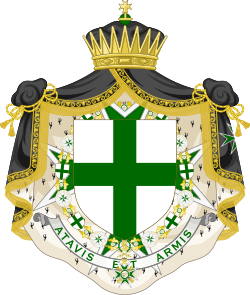
Sir Thomas Docwra was Grand Prior of the Order of Knights of the Hospital of Saint John of Jerusalem in England, and thus ranked as Premier Lay Baron of England.

Spondon is a ward of the city of Derby. Originally a small village, Spondon dates back to the Domesday Book and it became heavily industrialised in the 19th and early 20th centuries, with companies such as British Celanese.

A leper colony, lazarette, leprosarium, or lazar house was historically a place to isolate people with leprosy. The term lazaretto, which is derived from the name of the biblical figure Saint Lazarus, can refer to isolation sites, which were at some time also "colonies", or places where lepers lived or were sent. Many of the first lazarettes were operated by Christian monastic houses. Leper hospitals exist throughout the world to treat those afflicted with leprosy, especially in Africa, Brazil, China and India.

Chaddesden, also known locally as Chadd, is a large residential suburb of Derby, United Kingdom. Historically a separate village centred on Chaddesden Hall and the 14th century St Mary's Church, the area was significantly expanded by 20th century housing developments, and was incorporated into Derby in 1968.

The Order of Saint Lazarus of Jerusalem, also known as the Leper Brothers of Jerusalem or simply as Lazarists, was a Catholic military order founded by crusaders around 1119 at a leper hospital in Jerusalem, Kingdom of Jerusalem, whose care became its original purpose, named after their patron saint, Lazarus. It was recognised by King Fulk of Jerusalem in 1142 and canonically recognised as a hospitaller and military order of chivalry under the rule of Saint Augustine in the Papal bull Cum a Nobis Petitur of Pope Alexander IV in 1255. Although they were centered on their charism of caring for those afflicted with leprosy, the knights of the Order of Saint Lazarus notably fought in the Battle of La Forbie in 1244 and in the Defense of Acre in 1291. The titular seat was successively situated at Jerusalem, Saint-Jean-d'Acre and - after the fall of the Kingdom of Jerusalem - split in two main branches in Italy and in Château Royal de Boigny-sur-Bionne in France.
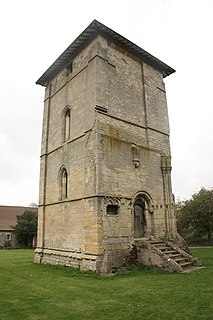
Temple Bruer Preceptory is a historic building in the civil parish of Temple Bruer with Temple High Grange, North Kesteven, Lincolnshire, England. It is one of the few Knights Templar sites left in England where any ruins remain standing. Its name comes from its Templar ownership and its position in the middle of the Lincoln Heath, bruyère (heather) from the French language current at the time. It was founded in the period 1150 to 1160 and the order was dissolved in 1312. The site is located between the A15 and A607 roads, 2.5 miles (4.0 km) north from Cranwell. The site has been excavated twice, firstly by the Rev Dr. G. Oliver, the rector of Scopwick in 1832-3, and in 1908 by Sir William St John Hope.

Rothley Temple, or more correctly Rothley Preceptory, was a preceptory in the village of Rothley, Leicestershire, England, associated with both the Knights Templar and the Knights Hospitaller.
William d'Aubigny, 1st Earl of Lincoln and 1st Earl of Arundel, also known as William d'Albini, William de Albini and William de Albini II, was an English nobleman. He was the son of William d'Aubigny "Pincerna" of Old Buckenham Castle in Norfolk, and Maud Bigod, daughter of Roger Bigod of Norfolk.

Sherburn Hospital is a medieval hospital located in the hamlet of Sherburn House to the southeast of Durham, England.

Burton Lazars is a village two miles (3 km) south-east of Melton Mowbray in Leicestershire having a population of c.450 in 2015. It is the site of the remains of the English headquarters of the military and hospitaller Order of Saint Lazarus. The official population as taken at the 2011 census is included in the civil parish of Burton and Dalby
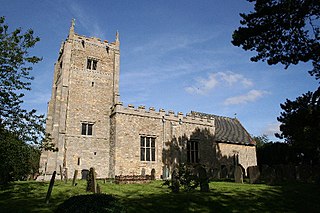
Carlton-le-Moorland, is a small, long-established village and civil parish in the North Kesteven district of Lincolnshire, England. It lies between the town of Newark-on-Trent and the city and county town of Lincoln. The parish population at the 2011 census was 565.
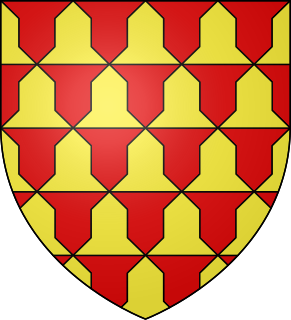
Robert de Ferrers, 6th Earl of Derby (1239–1279) was an English nobleman.

Locko Park is a privately owned 18th-century country house in between the villages of Stanley and Ockbrook in the borough of Erewash, near Spondon, Derbyshire, England. It is a Grade II* listed building.

Barrow Camera was a Knights Hospitaller foundation in the parish of Barrow upon Trent, Derbyshire, England.
Great Limber Preceptory, Limber Magna was a Camera (farm) of the Knights Templar and later the Knights Hospitaller in the village of Great Limber, Lincolnshire, England.

Ossington Preceptory was a preceptory of the Knights Hospitaller, near to the village of Ossington in Nottinghamshire, England.
Sir Roger de Mowbray was an Anglo-Norman magnate. He had substantial English landholdings. A supporter of King Stephen, with whom he was captured at Lincoln in 1141, he rebelled against Henry II. He made multiple religious foundations in Yorkshire. He took part in the Second Crusade and later returned to the Holy Land, where he was captured and died in 1187.
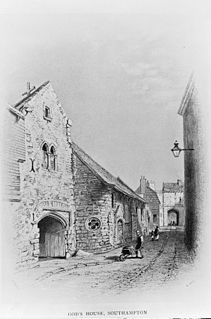
God's House Hospital was a refuge for poor travellers in Southampton, England. Much of the complex has now been destroyed, with only two buildings remaining: the gatehouse, God's House Tower, a grade I listed scheduled ancient monument, and a chapel, St. Julien's Church, a grade I listed building.

Sir William Burdet of Loseby in Leicestershire, England, was a Member of Parliament for the county seat of Leicestershire.
